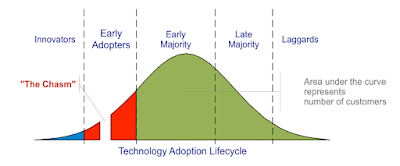Transforming the Entire Food Ecosystem
Where is the “food” part of this blog? I have been remiss in
providing an explanation of the title for my discussions – Agri-Food
Technology. Let me take a moment to shed some light on this subject.
 Optimizing the Chain
Optimizing the Chain
Possibly the best way to clarify this concept is to talk
about the food supply chain which is not
yet a value chain - but more on this
later. If you view food manufacturing in its’ entirety you get a sense of the
opportunity for optimization of the collective industries that make up this
dynamic continuum of agriculture and food. This ecosystem might not be broken
but it is a long way from being efficient.
Beginning with those companies that manufacture equipment or
crop inputs, including genetics, all the way to the consumer you get a sense of
what many refer to as “farm to fork”. Except in this case it is really “pre farm to fork”.
More with Less through GEM Data
How can a food and beverage processor benefit from
technology that their suppliers of raw product deploy? The answer is in the
data. And how can a grower benefit from sharing that data with their business
partners downstream from them? The simple answer is in the optimization of Genetics,
Environments and Management practices (GEM) that delivers better quality raw
goods resulting in better processing yields to their buyers who are willing to
pay for it.
All processors or food manufacturing executives can readily recite
the costs of production for each line item on their Income Statement. Containers,
ingredients, equipment, energy, labor, transportation, etc. (COGS), and, last but most
important and the largest figure of
all for first stage processors– raw product – is the one that typically receives
the least amount of attention from management.
Upwards of 40% of costs of producing a single can of peaches
can be attributed to the purchase of those peaches from the grower. Now if one
could somehow buy the same amount of product from farmers and produce just 1
more can of sliced juicy fruit or more than 1% more cases of finished goods
that money would go straight to the bottom line. No more effort. No more cost
(OK maybe the cans and other variable costs). Free peaches mean increased
profits for processors.
Give Me Your Watch to Tell You What Time It Is
Great! So now I have told most of you something that you
already knew. But how would you suggest that one go about getting free peaches?
Here it is again. The data.
Tomato processors have figured it out to some extent. They
know that better quality crops mean better processing yields overall. In the
case of paste manufacturing it is less water and more tomato (solids) that
drives improved output. There are other quality issues but for the most part it
the amount of solids that receives the lion’s share of the focus.
There are only three variables that can create a better
tomato. Genetics (seed, seedling), Environment (weather, soil) and Management
practices (crop inputs –nutrients, pesticides, water, labor, and equipment) and
the right combination of each of these can more consistently deliver not only
better quality for processors but better yields for growers.
Aggregation and analysis of the GEM data in and of itself
will not solve the problem of delivering a better “packout”. But combining this
data with production results can and will result in greater processing
efficiencies. There is, however, one operational requirement in order to
achieve the desired improvements.
Traceability Not Just for Recall Management
Without traceability, knowing where the product came from
(grower, farm, field, block) one cannot gain insights into what caused good or
bad processing yields. And without that critical tie between processing
performance and a particular products’ GEM there is no hope in determining “best”
combinations of GEM.
Value Chains Share
 Our old nemesis CHANGE rears its ugly head once more. The supply chain requires a transformation
to that of a value chain. What this
means is that processors and growers need to establish a very different
relationship than the one under which they currently operate.
Our old nemesis CHANGE rears its ugly head once more. The supply chain requires a transformation
to that of a value chain. What this
means is that processors and growers need to establish a very different
relationship than the one under which they currently operate.
Chain optimization means that value needs to be shared between
partners. Where there are gains there should be compensation provided to
those who deliver those gains. The growers’ costs for collecting and managing
the data needs not to be simply covered but should result in the payment of some
sort of premium. Incentives drive behavior. Just ask my pal Melika. Ball? Cookie? Squirrel?




